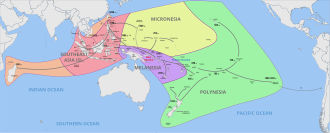Breadfruit
Tropical fruit used as a staple food in many cultures

Breadfruit (Artocarpus altilis) is a species of flowering tree in the mulberry and jackfruit family (Moraceae) believed to be a domesticated descendant of Artocarpus camansi originating in New Guinea, the Maluku Islands, and the Philippines. It is a staple food in many tropical regions.
Description[edit]
Breadfruit trees grow to a height of 21 meters (70 feet). The large, thick, dark green leaves are deeply cut into pinnate lobes. The trees produce a large, round, green fruit with a rough surface. The fruit is rich in starch and can be cooked and eaten at all stages of maturity.
History and Cultivation[edit]
Breadfruit has been cultivated for thousands of years. It was spread by Austronesian peoples throughout the Pacific Ocean, as shown in the

.
The plant was introduced to the Caribbean in the late 18th century by Captain William Bligh, who transported it from Tahiti to the Caribbean on the HMS Bounty. Today, breadfruit is grown in over 90 countries.
Culinary Uses[edit]
Breadfruit is a versatile food that can be roasted, baked, fried, or boiled. It is often used in dishes similar to potatoes. In the Philippines, it is known as "kolo" and is often sliced and fried, as shown in

. In the Caribbean, breadfruit is commonly fried, as depicted in

. It is also used in soups and stews.
Nutritional Value[edit]
Breadfruit is a good source of carbohydrates and dietary fiber. It also contains vitamins such as vitamin C and minerals like potassium.
Cultural Significance[edit]
Breadfruit holds cultural significance in many Pacific Island communities. It is often associated with traditional ceremonies and is considered a symbol of abundance and fertility.
Also see[edit]
Ad. Transform your life with W8MD's Budget GLP-1 injections from $75


W8MD offers a medical weight loss program to lose weight in Philadelphia. Our physician-supervised medical weight loss provides:
- Weight loss injections in NYC (generic and brand names):
- Zepbound / Mounjaro, Wegovy / Ozempic, Saxenda
- Most insurances accepted or discounted self-pay rates. We will obtain insurance prior authorizations if needed.
- Generic GLP1 weight loss injections from $75 for the starting dose.
- Also offer prescription weight loss medications including Phentermine, Qsymia, Diethylpropion, Contrave etc.
NYC weight loss doctor appointmentsNYC weight loss doctor appointments
Start your NYC weight loss journey today at our NYC medical weight loss and Philadelphia medical weight loss clinics.
- Call 718-946-5500 to lose weight in NYC or for medical weight loss in Philadelphia 215-676-2334.
- Tags:NYC medical weight loss, Philadelphia lose weight Zepbound NYC, Budget GLP1 weight loss injections, Wegovy Philadelphia, Wegovy NYC, Philadelphia medical weight loss, Brookly weight loss and Wegovy NYC
|
WikiMD's Wellness Encyclopedia |
| Let Food Be Thy Medicine Medicine Thy Food - Hippocrates |
Medical Disclaimer: WikiMD is not a substitute for professional medical advice. The information on WikiMD is provided as an information resource only, may be incorrect, outdated or misleading, and is not to be used or relied on for any diagnostic or treatment purposes. Please consult your health care provider before making any healthcare decisions or for guidance about a specific medical condition. WikiMD expressly disclaims responsibility, and shall have no liability, for any damages, loss, injury, or liability whatsoever suffered as a result of your reliance on the information contained in this site. By visiting this site you agree to the foregoing terms and conditions, which may from time to time be changed or supplemented by WikiMD. If you do not agree to the foregoing terms and conditions, you should not enter or use this site. See full disclaimer.
Credits:Most images are courtesy of Wikimedia commons, and templates, categories Wikipedia, licensed under CC BY SA or similar.
Translate this page: - East Asian
中文,
日本,
한국어,
South Asian
हिन्दी,
தமிழ்,
తెలుగు,
Urdu,
ಕನ್ನಡ,
Southeast Asian
Indonesian,
Vietnamese,
Thai,
မြန်မာဘာသာ,
বাংলা
European
español,
Deutsch,
français,
Greek,
português do Brasil,
polski,
română,
русский,
Nederlands,
norsk,
svenska,
suomi,
Italian
Middle Eastern & African
عربى,
Turkish,
Persian,
Hebrew,
Afrikaans,
isiZulu,
Kiswahili,
Other
Bulgarian,
Hungarian,
Czech,
Swedish,
മലയാളം,
मराठी,
ਪੰਜਾਬੀ,
ગુજરાતી,
Portuguese,
Ukrainian